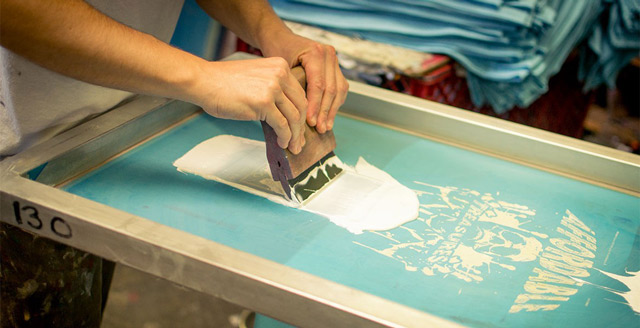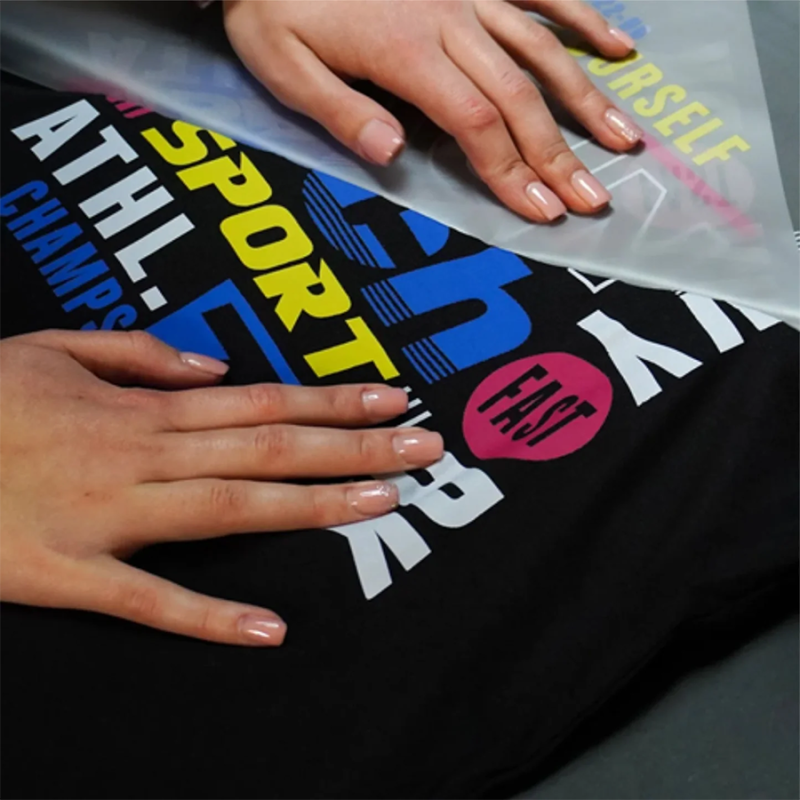The apparel decoration industry, from large-scale manufacturing workshops to individual Print-on-Demand (POD) ventures, is thriving. However, the path to profitability starts with a crucial question: which printing technology offers the best return on investment? Choosing the most suitable method is pivotal, as every technique has unique pros and cons that directly impact product quality, cost structure, and production efficiency. This definitive guide will conduct an in-depth comparison of the 4 most popular printing technologies today—Screen Printing, Heat Transfer, DTF, and DTG—to help you make the right strategic investment.
1. Screen Printing: The Durable Workhorse

Screen printing is the traditional, longest-standing technique, remaining popular due to its superior durability and unbeatable low cost for volume production.
Principle & Process: Ink is applied to the garment by being pushed through a fine mesh screen (stencil) that is only open in the design areas. Critically, each color requires a separate screen and pass, making setup time intensive.
Pros (SEO Focus: Durability & Cost-Efficiency):
- Lowest Unit Cost: Ideal for large volume orders (100+ units), where unit costs drop significantly after the initial setup.
- Exceptional Durability: The ink sits deep within the fabric fibers, resulting in a colorfast and highly durable finished print that withstands hundreds of washes.
- Special Effects: Allows for unique ink effects like puff, metallic, and glow-in-the-dark.
Cons (SEO Focus: Complexity & Limits):
- Color & Detail Limits: Impractical for complex designs, photographs, or graphics requiring many colors or intricate gradients.
- High Setup Time: The initial time spent creating screens and aligning colors makes it inefficient for small or one-off orders.
2. Heat Transfer Printing: The Budget Entry Point
eat transfer printing (using vinyl or printed transfer paper) is the simplest and most accessible method, often used by small businesses or for highly personalized items.
Principle & Process: The design is either cut from colored vinyl or printed onto special transfer paper/decal. This transfer is then placed on the garment and pressed using high heat and pressure, causing the image to bond to the fabric surface.
Pros (SEO Focus: Low Cost & Material Versatility):
- Very Low Startup Cost: Requires minimal initial investment (a basic printer, vinyl cutter, and heat press).
- Material Compatibility: Excels with polyester fabrics (ideal for sportswear) and garments that require simple logos or numbers.
- Speed for Small Batches: Quick and efficient for very small, custom orders.
Cons (SEO Focus: Longevity & Hand-Feel):
- Poor Longevity: The print sits atop the fabric and is prone to cracking, fading, or peeling after repeated washing.
- Plastic Hand-Feel: The decal or vinyl layer often creates a thick, stiff, and less breathable plastic feel (hand-feel).
3. DTF (Direct to Film): The Versatile Hybrid

DTF printing is a significant step forward, recognized as the “hybrid” solution because it offers the flexibility of digital methods combined with the adhesion benefits of heat transfer.
Principle & Process: The image is printed onto a PET film using specialized pigment inks (including a white underbase). Hot-melt adhesive powder is immediately applied to the wet ink. After curing the powder, the film is pressed onto the garment, transferring the image and adhesive layer.
Pros (SEO Focus: All-Fabric Capability & Detail):
- Ultimate Material Versatility: Prints effectively on all fabrics (100% cotton, polyester, blends, nylon, etc.).
- Excellent Dark Fabric Printing: The strong white ink underbase ensures vibrant, opaque colors on dark-colored apparel.
- Detail & Flexibility: Handles complex designs and gradients well, making it perfect for Print on Demand (POD) services.
Cons (SEO Focus: Equipment Cost & Comfort):
- Raised Hand-Feel: The adhesive and ink layer can result in a slightly raised or rubbery feel compared to DTG.
- Higher Equipment Cost: The specialized DTF printer, shaker/curing unit, and supplies (film, powder) require a notable initial investment.
4. DTG (Direct to Garment) Digital: The Quality King

DTG is the most modern technique, directly applying liquid ink onto the fabric fibers, similar to a paper inkjet printer. It is the choice for businesses prioritizing photorealistic quality.
Principle & Process: A purpose-built DTG printer jets ink directly into the fabric. Dark garments require a pretreatment chemical and a white ink base layer before the color inks are applied. The print is then cured with a heat press or tunnel dryer.
Pros (SEO Focus: Quality & Comfort):
- Highest Image Quality: Outstanding resolution and unlimited color capability, ideal for complex photographs, portraits, and intricate artwork.
- Soft Hand-Feel: The ink soaks into the fabric, providing a very soft, natural hand-feel that is highly breathable.
- Fast Small Orders: Excellent workflow for rapid, high-detail POD and single-item orders.
Cons (SEO Focus: Equipment Cost & Comfort):
- Material Constraint: Primarily works best on 100% or high-content cotton fabric; quality drops significantly on polyester blends.
- Highest Investment: Requires the most expensive equipment and specialized, high-cost inks.
Which Choice Is Optimal For You?
Choosing which printing technology to use depends on your business goals and target customers.
- For large volumes, simple designs, and low cost, choose Screen Printing.
- For sports apparel or polyester products with durable images, choose Heat Transfer Printing.
- For flexibility, printing on various fabrics (including dark cotton) with complex designs, choose DTF.
- For the highest image quality on cotton and cost is secondary, choose DTG.

